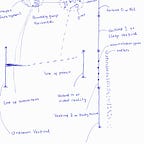Virtual Reality as Neuroimaging for Mental Health
When someone is in a depressive or anxiety crisis, the fMRI images of brain activity or EEG brain waves may do little in telling a story that could still the mind in a controlled way.
Though automatic thoughts have influence, there are ways that controlled thoughts override bubbles of those in situations. It is possible to see something that should cause panic, but determine that it is not what it looks like. This, internally, is telling thoughts not to go there.
How both controlled and automatic thoughts — start and drive — holds a key to seeing their causations better than current neuroimaging techniques.
This story, played as it is and in reverse, with virtual reality could become a placement for different situations with the possibility to induce more controlled thoughts over a state of mind.
Why do words hurt? Why can hurtful words not just be ignored, or dismissed? Why would a new spigot that gets damaged on an important weekend with guests cause a major meltdown? What is the relationship between that spigot and the eventual mood disorder?
These questions belong to the thought pathway in the brain — how thoughts emerge, then transport, to hold this power. Words that hurt aren’t just sound but thought that goes somewhere. Damaged spigot isn’t just an object, but a thought version that goes to a destination of upset.
In some cases of mental health, once it starts going and is not dismissed somehow, it goes on and on. This journey down feeling effect takes a lot of attention from other parts of the brain and may cause physical sensation elsewhere.
For some people they abuse substances, for others they have other coping mechanisms, but a possible reach of virtual reality in mental health is to show the thought pathway in the brain across situations, for the purpose of giving controlled thoughts a fighting chance.
